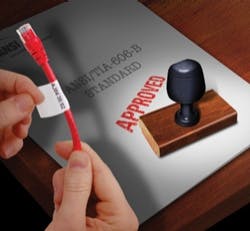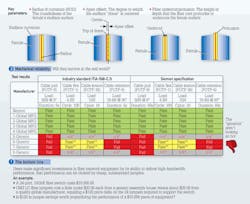There’s more to fiber-assembly performance than insertion loss
From the August, 2012 Issue of Cabling Installation & Maintenance Magazine
Looking at performance and physical characteristics beyond those required in testing specs revealed some eye-opening trends.
by Kevin Stronkowsky, Siemon
Many network performance problems occurring at the physical layer are directly related to the quality of cable assemblies. In fact, the overall performance and reliability of a network port is only as good as the cabling to which it is connected. This fact is particularly relevant in fiber-optic systems, where seemingly minute variances in tight fiber-connectivity tolerances can drastically undermine cabling performance. While some assembly-performance issues can be identified through field testing of installed channels, that testing is not inclusive of all potential issues. Field testing is a critical step, to be sure, but a passed field test may provide a false sense of security because a single passing result for the lone parameter of insertion loss does not guarantee the long-term reliability of a fiber-optic assembly.
We at Siemon undertook comprehensive benchmark testing on what we deemed to be a representative assortment of commercially available fiber assemblies. Our study included generic fiber jumpers purchased through online retailers that were produced by both domestic (U.S.) and offshore assembly houses, as well as assemblies that were produced and assemblies produced by other globally known brands. These assemblies were purchased through authorized distributors. The information presented in this article comes from the information derived from our study, including detail on mechanical and optical characteristics that are critical to the performance and longevity of these fiber-optic connections.
Testing setup
The tests were conducted on 36 random samples of duplex LC laser-optimized multimode Om3 50/125-micron fiber jumpers from nine suppliers—Siemon, four other recognized brand-name global manufacturers, and four generic assembly houses. We tested each assembly to our own internal specifications as well as to TIA and IEC standards for endface geometry, optical performance, cleanliness and mechanical reliability.
Insertion loss and return loss performance are fundamental parameters used to assess the compatibility of optical-fiber links and channels with the specific networking applications they support. Insertion loss is commonly used as the basis for acceptance testing of installed links and channels. Although return loss testing of installed cabling is not required by industry standards, it is a normative requirement for fiber connectors and assemblies. Return loss is critical to optical performance of links and channels because reflected optical signals can interfere with detectors on both the forward and rearward directions. These reflections degrade signal-to-noise ratio (SNR) and are commonly presented using “eye diagrams,” in which a higher return loss is evident by a smaller eye opening. Likewise, testing in both directions and at both wavelengths will detect abnormalities that degrade optical performance of cabling channels.
While insertion loss typically is the only field measurement taken, it is not the only parameter that can affect assembly (and therefore network) performance and reliability. Control of endface geometry, cleanliness, surface defects and mechanical integrity all should be considered. We evaluated the 36 samples from the nine suppliers for these parameters as well.
Endface geometry
Overall performance of fiber-optic connectivity depends on the mechanical characteristics that control alignment and physical contact of the fiber cores. Endface geometry is an essential characteristic of repeatable and reliable optical-fiber connections.
The three critical parameters for connector endface geometry are: 1) radius of curvature (ROC), the roundedness of the ferrule’s endface surface; 2) apex offset, the degree to which the endface “dome” is centered; 3) fiber undercut/protrusion, the height or depth that the fiber core protrudes or undercuts the ferrule surface.
As a result of extensive research on the effects that endface variation has on performance and intermateability, we at Siemon have adopted specifications that exceed industry standards for all three measurements. The table showing results of endface-geometry testing includes both IEC industry-standard specifications as well as our own in-house specifications.
Because the quality and consistency of the physical contact between fiber cores depends on endface geometry, it must be rigorously controlled to support the premise that cabling is fully intermateable and interoperable. Otherwise the percentage of mated connections that do not conform to optical-performance requirements will statistically increase. Poor endface control increases the risk that a connection that passes on day one will have trouble on day two.
A connection between a jumper having non-compliant endface geometry and one that is standard-compliant will exhibit inconsistent test results. For example, optical-fiber links that pass acceptance testing using a compliant reference cord will exhibit higher optical loss and greater variability when replacing the reference cords with non-compliant jumpers.
Contamination and defects
Fiber-core fractures and the presence of contamination on ferrules, alignment sleeves or dust caps cause wide variations in both insertion-loss and return-loss performance. These issues are separate from endface geometry, but have an equally significant impact on first-pass yield for cabling-acceptance testing. More importantly, these irregularities undermine network integrity because uncorrected contamination or fractures interfere with optical performance and results are highly variable, as well as unpredictable.
Surface defects and cleanliness are critical, but will not always be detected with insertion loss or endface-geometry testing. A smooth but fractured fiber will not necessarily fail endface-geometry checks for radius of curvature, apex offset and fiber height. Because proper cleanliness of the fiber jumper during manufacturing and installation is critical to reliability and optical performance, we use automated endface inspection for jumper cleanliness and surface defects, according to the IEC 61300-3-35 and IEC 62627 specifications. This equipment automatically detects surface defects and contamination that can directly impact performance.
With the exception of our own brand, all random samples that we tested were received with some form of contaminated endface and failed the automated visual test against IEC 61300-3-35 specs. After proper cleaning 75 percent passed with some defects, and 25 percent failed.
Non-compliant enface geometry and contamination are the leading causes of erratic optical test results in the field; they are responsible for wasted time and effort spent troubleshooting optical-fiber cabling. These isues translate to low-first-pass yield on acceptance testing of installed fiber-cabling channels. Faced with time constraints, installers will sometimes retest until they achieve a passing result. But unless the non-compliant jumpers are replaced, they pose a risk of unacceptably high insertion loss for the channel on “day two.”
Another problem is that contamination can act like a virus, transferred onto reference jumpers and the equipment interface. Even if the infected jumper is replaced, the damage is already done.
Mechanical reliability
Several tests are required as part of industry-standard specifications for mechanical reliability. Mechanical reliability parameters include flex testing, torsion testing, pull testing, cable retention, impact testing, vibration testing, durability, and transmission with an applied load. These mechanical tests verify that a fiber jumper can endure the installation and maintenance performed in a typical fiber-optic network, and that they can dependably withstand the internal stresses imposed by spring-loaded physical contact over time in a variety of environmental conditions.
The mechanical tests we performed on each assembly were cable pull, flex, tension and retention. And again, we include in the table the test results against industry-standard specifications (in this case, TIA-568-C.3), as well as against our own internal specifications.
We place a significant emphasis on endface geometry, cleanliness, surface-substrate integrity and mechanical performance, specifically because field testing of optical-fiber links is necessary but not sufficient to guarantee the integrity of installed optical-fiber cabling.
One reason it is insufficient is because link testing does not include the fiber jumpers used for equipment connections on either end of the link. Another reason is that insertion loss is the only required transmission parameter for optical-fiber cabling specified in industry standards.
For these reasons it is essential to ensure that optical fiber cables, components and assemblies are fully standards-compliant. One way to do so is to require that all fiber assemblies arrive with objective evidence of return-loss and insertion-loss testing, in both directions, and at both wavelengths (850 and 1300 nm).
This study’s results indicate that generic fiber jumpers from assembly houses are least likely to pass these important parameters. The dollars saved from using substandard fiber jumpers hardly seem worth putting critical network performance and reliability at risk.::
Editor’s note: This article and the accompanying graphic are derived from a white paper authored by Siemon and entitled “A closer look at fiber-optic cable assemblies.” The paper is available at Siemon’s website. The paper includes additional images, such as visuals of aligned and misaligned apex offset, symmetrical and asymmetrical radius of curvature, contaminated endfaces and those with surface defects, as well as assemblies that failed axial and pull tests.
Kevin Stronkowsky is fiber-optic product manager with Siemon (http://www.siemon.com).


